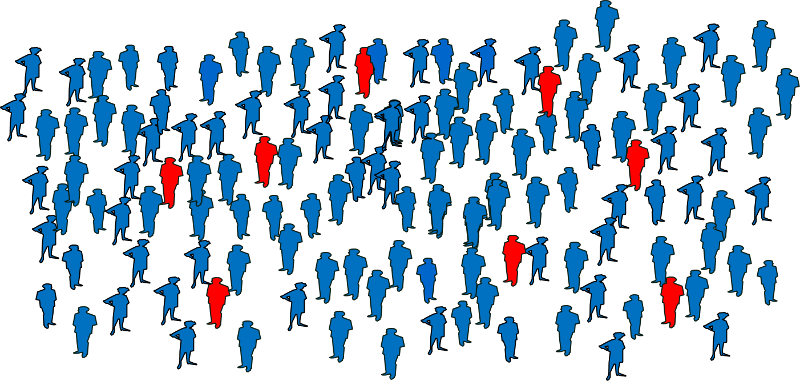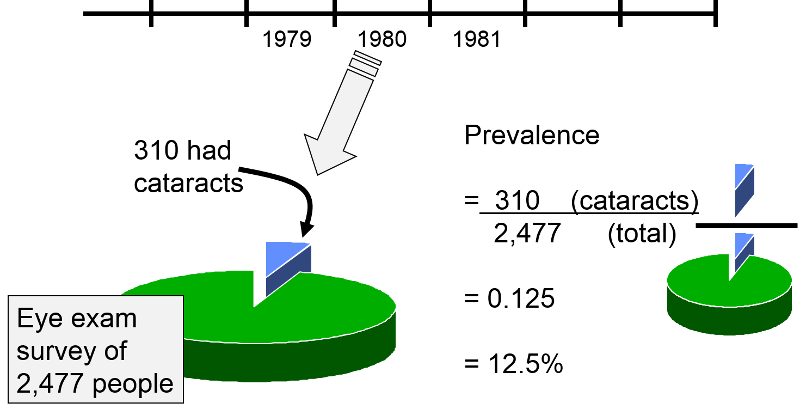Prevalence
The measure of disease frequency we have calculated is the prevalence, that is, the proportion of the population that has disease at a particular time. Prevalence indicates the probability that a member of the population has a given condition at a point in time. It is, therefore, a way of assessing the overall burden of disease in the population, so it is a useful measure for administrators when assessing the need for services or treatment facilities.
Epidemiologists sometimes make a distinction between point prevalence, the proportion of the population at a 'point' in time. So it includes all previous cases who are still have the condition and are still members of the population. A good way to think about point prevalence is to imagine that you took a snapshot of the poplation and determined the proportion of people who had the condition of interest at the time the snapshot was taken.
Example: The percentage of a class reporting symptoms of seasonal allergies during the first week in May 2016.

Period prevalence is similar to point prevalence, except that the "point in time" is broader. For example, suppose that 2,477 residents of Framingham, MA were examined the establish the proportion of the population that had cataracts. It may have taken 2-3 years to conduct all of the eye exams, and when they were done the prevalence over this observation period would include people who had acquired cataracts previously if they still lived in that populations, and it would also include newl cases, i.e., those who had developed cataracts during the 2-3 year period when the eye exams were conducted. So, it can just be thought of as a wide "point in time".
Example: During 1980 the Framingham Het Study examined 2,477 subjects for cataracts and found that 310 had them. So, the prevalence was 310/2,477 = 0.125.

This can conveniently be expressed as 12.5 per 100 or 12.5% (per cent means 'per hundred'). Since the examination of these subjects took place over a year, it might be referred to as a period prevalence , and the numerator conceivably could include people who had first developed cataracts prior to 1980 and people who developed cataracts during 1980 just before their exam was done. Note that all people counted in the numerator are also included in the denominator, i.e., the numerator is a subset of the denominator.
, and the numerator conceivably could include people who had first developed cataracts prior to 1980 and people who developed cataracts during 1980 just before their exam was done. Note that all people counted in the numerator are also included in the denominator, i.e., the numerator is a subset of the denominator.
Frequently, this distinction between point prevalence and period prevalence is blurry, because it is rare to be able to assess the proportion of a population that has a disease condition at exactly the same point in time. We could consider our class to be a population, and I could ask the students to raise their hand if they had an upper respiratory tract infection today. I could even take a photo and use this to visualize the prevalence of respiratory infections at this point in time. So, in this case this snapshot of disease frequency in the class would truly represent prevalence at a point in time. In most cases, however, it takes much longer than an instant to assess the proportion of a population that is diseased. In other words, we have to be flexible in our definition of a "point" in time, and we have to allow for broad points. Regardless, of this distinction between point prevalence and period prevalence, the more important concept is that prevalence is a measure of the proportion of the population that has a given disease, condition, or characteristic at a given time. We will not try to distinguish point and period prevalence in EP713.

|
Notes on Prevalence Note that we can also use prevalence to assess the frequency of behaviors or characteristics that might be risk factors for disease. Smoking isn't a disease per se; it is a risk factor. However, it is relevant to assess the prevalence of this behavior. Also, note that the "point in time" can be an event rather than a distinct calendar time. For example, many elderly men are found to have prostate cancer on autopsy, even though they were unaware of it and died for other reasons. It is appropriate to think of the frequency of prostate cancer at the time of autopsy as prevalence, even though men are having autopsies performed at many different points in calendar time. Similarly, military recruits undergo a physical examination during induction, and the exams are performed at many different times. Nevertheless, the proportion of inductees found to be colorblind during their physical exam would be the prevalence of colorblindness in young men.
|
Note that prevalence is a proportion and not a rate, although the latter term is often used. So, the terms "prevalence rate" and "autopsy rate" are technically incorrect (although commonly used).

Question: When calculating point prevalence, what should you do with people who were in the population, but they died or moved out of the population?



